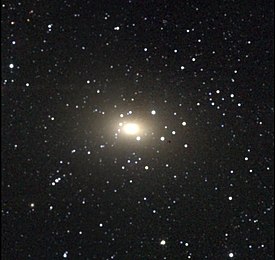Maffei 1
| Maffei 1 | |
|---|---|
 |
|
| Observation data (J2000 epoch) | |
| Constellation | Cassiopeia |
| Right ascension | 02h 36m 35.4s |
| Declination | +59° 39′ 19″ |
| Helio radial velocity | 66.4 ± 5.0 km/s |
| Distance |
2.85 ± 0.36 Mpc 4.4+0.6 −0.5 Mpc |
| Apparent magnitude (V) | 11.14 ± 0.06 (V-band) |
| Characteristics | |
| Type | S0− pec, E3 |
| Size | 75,000 Ly (23,000 Parsecs) |
| Apparent size (V) | 3′.36 × 1′.68 |
| Other designations | |
| PGC 9892,Sharpless 191 | |
Maffei 1 is a giant elliptical galaxy in the constellation Cassiopeia. Once believed to be a member of the Local Group of galaxies, it is now known to belong to its own group, the IC 342/Maffei Group. It was named after Paolo Maffei, who discovered it and the neighboring Maffei 2 in 1967 via their infrared emissions.
Maffei 1 is a slightly flattened core type elliptical galaxy. It has a boxy shape and is made mainly of old metal-rich stars. It has a tiny blue nucleus in which stars continue to form. Like all large ellipticals it contains a significant population of globular clusters. Maffei 1 is situated at an estimated distance of 3–4 Mpc from the Milky Way. It may be the closest giant elliptical galaxy.
Maffei 1 lies in the Zone of Avoidance and is heavily obscured by the Milky Way's stars and dust. If it were not obscured, it would be one of the largest (about 3/4 the size of the full moon), brightest, and best-known galaxies in the sky. It can be observed visually, using a 30–35 cm or bigger telescope under a very dark sky.
The Italian astronomer Paolo Maffei was one of the pioneers of infrared astronomy. In the 1950s and 60s, in order to obtain high quality images of celestial objects in the very near infrared part of the spectrum (the I-band, 680–880 nm), he used chemically hyper-sensitized standard Eastman emulsions I-N. To achieve the hyper-sensitization he immersed them in 5% ammonia solution for 3–5 minutes. This procedure increased their sensitivity by an order of magnitude. Between 1957 and 1967 Maffei observed many different objects using this technique, including globular clusters and planetary nebulae. Some of those objects were not visible at all on blue light (250–500 nm) sensitive plates.
...
Wikipedia
